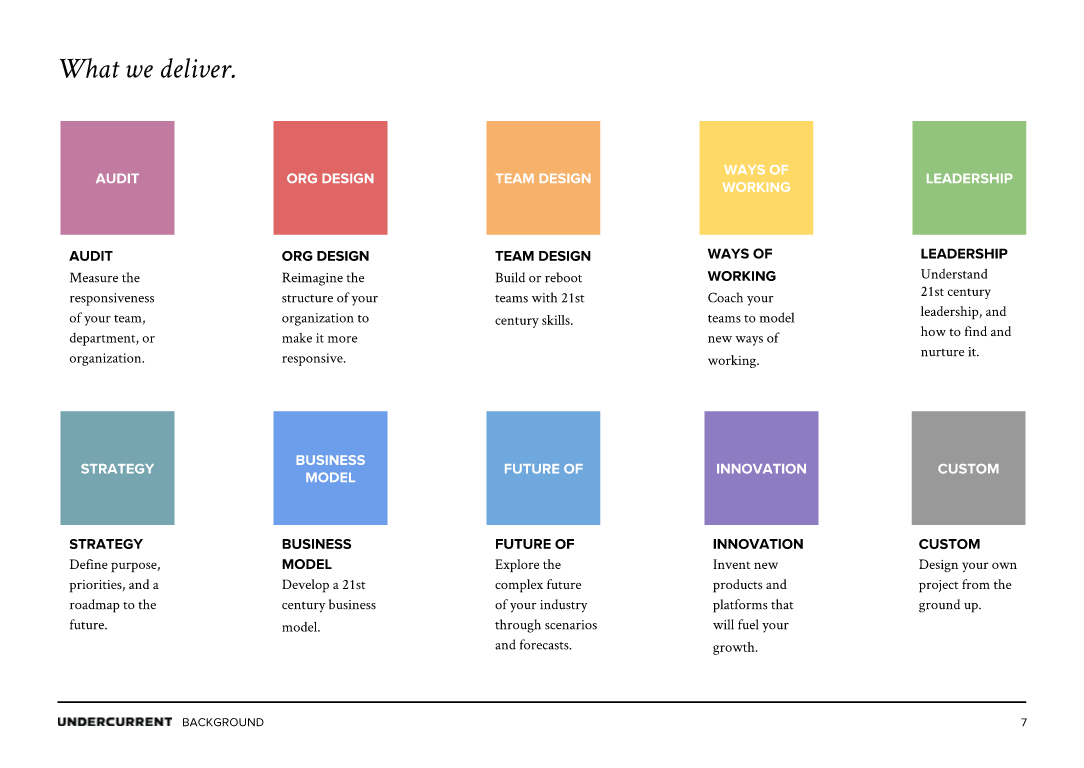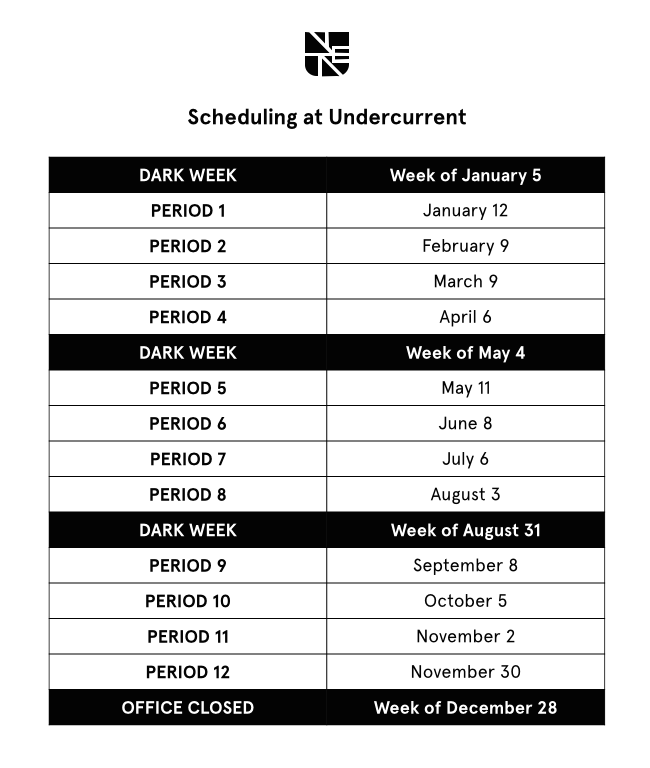Scheduling at Undercurrent

Standardizing timing changes everything.
Scheduling and resourcing used to be a complete mess at Undercurrent. Individuals and teams would be double- and triple-booked some weeks, while their colleagues had nothing to do. Building a team required hours of concerted effort: Who works well together? What’s the right team for this work? What special skills are needed? What start date works for the team we want? Do any of our current team-members have ongoing relationships with the client(s) in question? When one of the people on the team goes on vacation, what’s our backup plan?
Hard work shouldn’t be hard to schedule.
While I can’t say today that our scheduling and resourcing system is perfect, we’re getting closer with every Period. (More on that later.)
In February of last year, Aaron and I were in a taxi headed to the Charlotte airport after a successful initial new-business meeting, and we wondered what it would have been like if we had a small, standardized menu of pricing and services from which clients could pick. Perhaps there’d be 5–7 types of work that we could do, but everything would be sold in fixed-price, fixed-team months. The methods and deliverables would be scaled to fit the time and the team, instead of the other way around. And the size and composition would always be the same — one Team Leader and two Team Members. In that way, we’d essentially have one thing to sell at one price. No more rate cards, no more customizing SOWs, and importantly just a couple decisions for a client: when to start and what kind of service. We built up a “Standard Offering” document, inclusive of 10 offering types, a standard team structure, and a standard monthly fee. We got consent to make a role in our Core management team that had exclusive ownership of the document and off we went. Within 6 weeks, 80% of our projects were standardized in terms of price and team structure, and selling our work got easier. It worked!

Unfortunately, the success of this concept had an unintended negative consequence: it put an even brighter light on our resourcing and scheduling issues. It was clearer than ever that our teams were pulled in too many directions at once. Over the next several months, we tried a bunch of different solutions to fix resourcing and scheduling, including: an open marketplace for resourcing (first-come, first-served); smaller dedicated teams that did their own selling; giving the responsibility for resourcing to a single soul. None of this had much of an impact on the core problem, and each introduced their own issues into the mix. Open marketplaces put intense negative pressure on client relationships (the person who knows the client best may be pulled away at any moment), smaller teams created fewer opportunities to level up, and single-owner resourcing was a total nightmare for the owner (me) every four weeks.
Standardized Timing
One Sunday afternoon in August — at the end of a long bike ride — a solution appeared: standardize the timing, and let everything else flex. The next week, I introduced the concept to the Client team, and as of 9/29 of 2014, we’ve been on a standard, Periodized schedule. Instead of 12 irregular months, we now break the year into 13 four-week periods. We offer 12 of these for paid client work, and we reserve the 13th for reviews, offsites, and knowledge-sharing, by breaking up the weeks and spreading them out with one week separating every four Periods of work. The final week is for end-of-year vacation. In doing so, we leave about $1MM on the table, but it’s a worthwhile investment.

Benefits
This means that working with us is a little different. We have a fixed set of start dates, and all our projects are delivered in four-week increments (which we call “Cycles”). As mentioned, our pricing and team structures are also fixed, so there’s very little to contemplate when working with us. So standardized pricing and timing, taken together, have made our offering very easy to buy. Which makes our lives a lot simpler and our revenue a lot more predictable.
It’s also had amazing knock-on effects for our internal operations that have made it one of the single most important changes we made in 2014.
- We’re able to be deliberate about how we staff teams. Because everything starts and ends on shared dates, we can be flexible when we need to be and rigid when we don’t. Some projects need a just right combination of talent. Others need long-term commitment. We can offer both options with minimal disruption.
- We can maintain a fixed number of team-members who are “off” for a Cycle, so that we always have a little slack in the system. If people need time to devote to a personal project, or want to try working on the business rather than in the business, we can easily take on those requests.
- We can be intentional about how we plan for team meetings, governance, and the overall rhythms of the workplace. Each week can have a deliberately chosen theme and way of working, and we can predict when teams will be stressed — and design schemes to support our members in particular ways.
- We can be smart about how and when we bring on new folks, too. We haven’t yet built strong training programs for our newbies, but standardized timing makes a program like this incredibly simple to spin up.
Policy
For you policy-nerds, here’s the actual text of the relevant policies at play in our governance.
Project Standards
Undercurrent Cycles use a schedule of standardized start dates to ensure simple, high-quality, transformative resourcing. Growth and Client Teams have until September 26, 2014 to transition current projects to this rhythm, and are authorized to extend current project plans as necessary.
The Closer will communicate to the client contact that work will begin on standard start dates and not before.
There will be 12 cycle periods each year, with one cycle period held for UCU Weeks and a closed holiday week at the end of the year.
Cycle start dates for 2015 are:
1 January 12
2 February 9
3 March 9
4 April 6
5 May 11
6 June 8
7 July 6
8 August 3
9 September 8
10 October 5
11 November 2
12 November 30
UCU Weeks
One full week at the beginning of each trimester is held for 2 days away from work and technology for group reflection on the business. The remaining days should be used for reviews, project postmortems, and knowledge sharing.
UCU T21 — Week of January 5
UCU T22 — Week of May 4
UCU T23 — Week of August 31
Maximum Capacity and “Off Cycle” Members
- Utilization is capped at 2 cycles fewer than we currently have Members to deliver. Example: if UC has 18 Team Member role-fillers at the start of a cycle, the capacity for that cycle is 16.
- Members who are “Off Cycle” are encouraged to support and sub-in temporarily on projects that need extra help, work on internal projects, work on special personal projects, and take vacation.
Signature Cutoff Date
The signature cutoff date for all new cycles is two weeks before the start of the next cycle. Example: if a cycle begins Monday 10/27, the cutoff date for new additions is Monday 10/13.

Comments